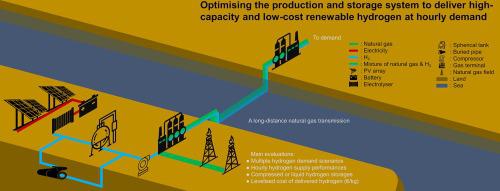Energy Conversion and Management ( IF 10.4 ) Pub Date : 2022-11-08 , DOI: 10.1016/j.enconman.2022.116398 Tubagus Aryandi Gunawan , Marco Cavana , Pierluigi Leone , Rory F.D. Monaghan

|
This paper presents the results of techno-economic modelling for hydrogen production from a photovoltaic battery electrolyser system (PBES) for injection into a natural gas transmission line. Mellitah in Libya, connected to Gela in Italy by the Greenstream subsea gas transmission line, is selected as the location for a case study. The PBES includes photovoltaic (PV) arrays, battery, electrolyser, hydrogen compressor, and large-scale hydrogen storage to maintain constant hydrogen volume fraction in the pipeline. Two PBES configurations with different large-scale storage methods are evaluated: PBESC with compressed hydrogen stored in buried pipes, and PBESL with liquefied hydrogen stored in spherical tanks. Simulated hourly PV electricity generation is used to calculate the specific hourly capacity factor of a hypothetical PV array in Mellitah. This capacity factor is then used with different PV sizes for sizing the PBES. The levelised cost of delivered hydrogen (LCOHD) is used as the key techno-economic parameter to optimise the size of the PBES by equipment sizing. The costs of all equipment, except the PV array and batteries, are made to be a function of electrolyser size. The equipment sizes are deemed optimal if PBES meets hydrogen demand at the minimum LCOHD. The techno-economic performance of the PBES is evaluated for four scenarios of fixed and constant hydrogen volume fraction targets in the pipeline: 5%, 10%, 15%, and 20%. The PBES can produce up to 106 kilotonnes of hydrogen per year to meet the 20% target at an LCOHD of 3.69 €/kg for compressed hydrogen storage (PBESC) and 2.81 €/kg for liquid hydrogen storage (PBESL). Storing liquid hydrogen at large-scale is significantly cheaper than gaseous hydrogen, even with the inclusion of a significantly larger PV array that is required to supply additional electrcitiy for liquefaction.
中文翻译:

用于高容量、可调度、长距离能量传输的太阳能氢——注入 Greenstream 天然气管道的案例研究
本文介绍了从光伏电池电解系统 (PBES) 生产氢气并注入天然气传输线的技术经济模型的结果。利比亚的 Mellitah 通过 Greenstream 海底天然气输送线与意大利的 Gela 相连,被选为案例研究的地点。PBES 包括光伏 (PV) 阵列、电池、电解槽、氢气压缩机和大型储氢装置,以保持管道中恒定的氢气体积分数。评估了具有不同大规模存储方法的两种 PBES 配置:在埋管中存储压缩氢气的 PBES C和 PBES L用储存在球形罐中的液化氢。模拟每小时 PV 发电量用于计算 Mellitah 中假设 PV 阵列的特定小时容量因子。然后将此容量因子与不同的 PV 尺寸一起用于确定 PBES 的尺寸。交付氢气的平准化成本 ( LCOH D ) 被用作通过设备尺寸优化 PBES 尺寸的关键技术经济参数。除光伏阵列和电池外,所有设备的成本都与电解槽尺寸有关。如果 PBES 在最低LCOH D下满足氢气需求,则认为设备尺寸是最佳的. PBES 的技术经济性能针对管道中固定和恒定氢气体积分数目标的四种情况进行评估:5%、10%、15% 和 20%。PBES 每年可生产高达 106 千吨的氢气,以实现 20% 的目标,压缩氢存储 (PBES C ) 的LCOH D为 3.69 欧元/千克,液态氢存储 (PBES L ) 的 LCOH D 为 2.81 欧元/千克。大规模储存液态氢比气态氢便宜得多,即使包含一个更大的光伏阵列,需要为液化提供额外的电力。


























 京公网安备 11010802027423号
京公网安备 11010802027423号